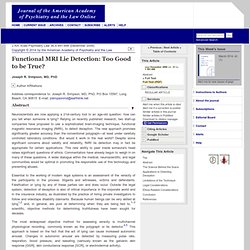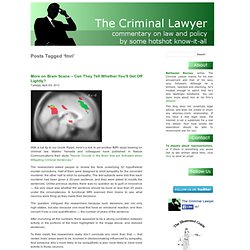

V11_Article_4__Shafi. Lie Detection : Cephos. Cross-Cultural Variation and fMRI Lie-Detection (Tommaso Bruni) 3 lab.

If the experiments do not possess a sufficient degree of external and ecological validity, they are unlikely to provide error rates that are applicable to the real world and to gain general acceptance in the scientific community. But if the real-life error rates and general acceptance are absent, fMRI lie-detection will probably not be accepted as a valid expert testimony either in the jurisdictions that follow the Daubert ruling (Daubert v. Merrell Dow Pharmaceuticals, Inc., 1993) or in those that adopt the older Frye (Frye v. United States, 1923) test. This is because both tests take general acceptance into account and because one of the Daubert standards is the “known or potential error rate” in real life applications. The concept of 'culture' Truth or lie? Can MRI help scientists read our minds? By Dr Donna Rose Addis, Centre for Brain Research, University of Auckland It’s the slogan of a new game show on TV3, but can science help us tell the two apart?

Mind Reading has always been thought of as a superhuman skill, but fMRI technology is bringing us ever closer to this goal. So-called ‘functional Magnetic Resonance Imaging’ tracks blood oxygen levels across the brain, allowing scientists to visualise what brain regions ‘light up’ during different types of cognition. This blog applies a New Zealander’s view. Supreme Court makes narco, lie detector, brain mapping tests illegal. Police cannot use the techniques or investigate leads arising thereof unless suspects volunteer.

In a major setback to investigating agencies, the Supreme Court (SC) on Wednesday ruled compulsory brain mapping, narco-analysis and lie detector tests unconstitutional as they violate individual rights. “We hold that no individual should be forcibly subjected to any of the techniques in question, whether in the context of investigation in criminal cases or otherwise. Doing so would amount to an unwarranted intrusion into personal liberty,” a bench of chief justice KG Balakrishnan, and justices RV Raveendran and JM Panchal said.
Information gained through the tests is already inadmissible in the country’s courts, but the SC ruling makes it clear that the police cannot use the tests or investigate any leads arising thereof unless suspects volunteer. Neural circuits in the brain that are activated when mitigating criminal sentences : Nature Communications. Comparison of activity during judgments of sympathy, and sentence reduction, suggest that activity in DMPFC (also known as paracingulate), precuneus (also known as posterior cingulate) and TPJ reflect a judgment-action circuit, which is illustrated in Fig. 2.

Strength of sympathy judgments is associated with activity in DMPFC, precuneus and TPJ. DMPFC is involved in general mentalising11 and is active when empathizing12 or sympathizing13 with others in pain. Precuneus has been linked to subjective perspective taking14, 15, 16. Functional MRI Lie Detection: Too Good to be True? Joseph R.

Simpson, MD, PhD + Author Affiliations Address correspondence to: Joseph R. Simpson, MD, PhD, PO Box 15597, Long Beach, CA 90815. E-mail: jrsimpsonmd@earthlink.net Abstract Neuroscientists are now applying a 21st-century tool to an age-old question: how can you tell when someone is lying? Fmri - The Criminal Lawyer - Commentary on Law and Policy. Guilt or innocence, one might say, is all in the mind.

After all, there are very few crimes that can be committed without the requisite mens rea, or mental state. If we’re going to punish someone, their acts cannot have been mere accident. We want to know that they had some knowledge that their actions could cause harm, and we want that awareness to be sufficiently high as to require punishment. Judge Issues Legal Opinion in Brooklyn fMRI Case. The judge in a recent Brooklyn case in which brain scan evidence was offered has delivered an opinion on why he ultimately excluded the fMRI data.

In Judge Robert H. Miller’s written opinion, obtained by Wired.com, he decided that under the Frye test, which is slightly different from the Daubert standard used in federal court, lie detection evidence contravenes a jury’s key right to decide the credibility of witnesses. The plaintiff in Miller’s case had attempted to establish a key witness was telling the truth. “Since credibility is a matter solely for the jury and is clearly within the ken of the jury, plaintiff has failed to meet this key prong of the Frye test and no other inquiry is required,” Miller wrote. Stanford Center for Law & the Biosciences Blog. The Stanford Center for Law and Biosciences has decided to leave the WordPress servers for greener pastures: namely, the Stanford Law School blog aggregator.

This address will no longer be updated. All posts from this address have been migrated to the new address: Please update your bookmarks and RSS feeds accordingly. Much, though not all, of the work in Law and Neuroscience has focused on the uses of fMRI. There are some good reasons for that focus. One reason to remember this is that fMRI has come under some prominent scientific fire lately – or, at least, the claimed results of some fMRI experiments have.
Science in court: Head case.